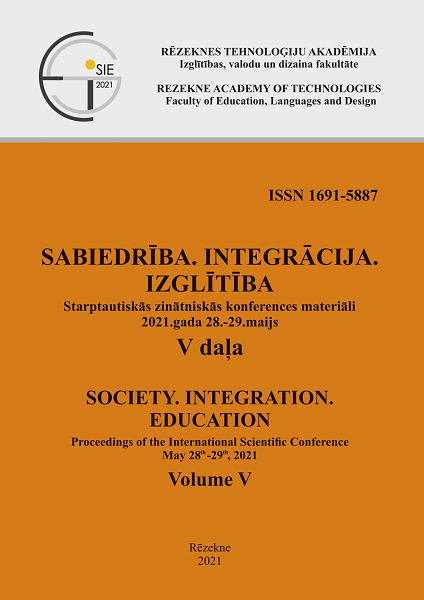PHYSICAL ACTIVITY OF STUDENTS AT HIGHER EDUCATIONAL INSTITUTIONS WITH KINESIOLOGY AND HEALTH MAJORS IN THE SETTING OF COVID-19 PANDEMIC
DOI:
https://doi.org/10.17770/sie2021vol5.6343Keywords:
physical activity, students, COVID-19 pandemicAbstract
The purpose of this study was to discover the peculiarities of students’ physical activities that study at higher educational institutions with kinesiology and health majors in the setting of COVID-19 pandemic. In order to accomplish it, an online survey was conducted among a total of 236 students of Lviv State University of Physical Culture named after Ivan Boberskyj. With its help, we were able to determine both domestic and organized physical activity levels’ self-assessments of the sample group before and during the quarantine restrictions. The majority of the students evaluated their physical activity levels as “excellent” and “good”. No significant changes among the physical activity assessments were not tracked during the quarantine restrictions. We established that 59% of the study group had regularly visited gyms before the pandemic breakout and 12% of the students systematic did home exercises. The remainder of active students (26%) exercised seldom. Before the pandemic, only 3% of the participants had not engaged themselves into organized physical activities. We observed an overall studentship physical activity decrease in terms of instances and intensity during the quarantine limitations. The forms of physical activities were substantially changed. Thus, the students began to stroll more often, as well as train alone or with online-coaches. Cardio and muscle strengthening remained dominant among activities both before and after the quarantine. After the quarantine restriction weakening, half of the study group re-embarked on gym training. 28% of the students continued exercising the same way they did during the quarantine. 12% of the respondents exercised on their owns. 7% of the participants did not return to training. With the respect to the results of this study, we can infer that Ukrainian students prefer group exercises where they can interact with either coach or other participant of the training sessions, as well as modern technologies cannot fully fulfill their needs of physical activity.
References
Balatska, L., Liasota, T., Nakonechnyi, I., Hakman, A., Bezverkhnia, H., Kljus, O., Osadchenko, T., & Semenov, A. (2020). Motor activity of different social groups: [Collective monograph]. Riga, Latvia : “Baltija Publishing”.
Ding, D., del Pozo Cruz, B., Green, M., & Bauman, A. (2020). Is the COVID-19 lockdown nudging people to be more active: a big data analysis. British Journal of Sports Medicine, 54(20), 1183-1184. Retrieved from https://bjsm.bmj.com/content/54/20/1183
Solovei, A., Rymar, O., Yaroshyk, & Sorokolit, N. (2017). The current state and the peculiarities of physical activity of teenagers in Ukraine and Poland. Physical Education, Sports and Health in Modern Society: Collected Research Papers of Lesya Ukrainka Eastern Europian National University, 1 (37), 91-96.
Sorokolit, N., Kukhar, M. (2019). Monitoring the health of first- and second-year students. Scientific and pedagogical problems of physical culture (physical culture and sports), 533-538. Retrieved from http://repository.ldufk.edu.ua/handle/34606048/24169
Tison, G., Avram, R., Kuhar, P., Abreau, S., Marcus, G., Pletcher, M., & Olgin, J. (2020). Worldwide Effect of COVID-19 on Physical Activity: A Descriptive Study. Annals of Internal Medicine, 173(9). Retrieved from https://doi.org/10.7326/M20-2665
Yaroshyk, M., Malanchuk, H., & Solovei, A. (2020). Assessment of the state of emotional health of Ukrainian university student youth that is involved into different levels of physical activity. Conference Society. Integration. Education Procedeenigs, 6, 467-475.
Zavydivska, N. N., Rymar, O. V., & Malanchuk, H. H. (2015). Innovative mechanisms of improvement of student’s physical education system on the basis of interdisciplinary connections. Journal of Physical Education and Sport, 15(4), 758-764.
Zavydivska, O., Zavydivska, N., Khanikiants, O., & Rymar O. (2017). The paradigm of health maintenance at higher education institutions as an important component of human development in terms of modernity. Journal of Physical Education and Sport, 17 (1), 60-65.






